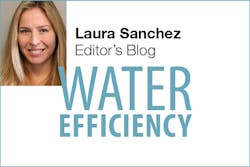Polyfluroalkyl substances (PFAS), persistent man-made chemicals used in a variety of industries and applications, have been linked to harmful health effects. Yet these chemicals exist in concentrations exceeding the EPA’s 70 parts per trillion advisory level in water supplies across the US. As water utilities grapple with how to remove these molecules, a handful of promising new technologies and treatment methods are emerging.
Water utilities today have three primary options for PFAS removal: reverse osmosis, ion-exchange resins, and granular activated carbon traps. While these methods are effective at physically trapping PFAS molecules, they are also prone to fouling. Furthermore, once PFAS molecules are sequestered in a filter medium, utilities are saddled with either disposing of concentrated toxic liquid or incinerating the filter material.
On a molecular level, PFAS have a hydrophilic “head” and a long hydrophobic “tail” connected by carbon-fluorine bonds. This bond, according to Chemical & Engineering News, is one of the strongest bonds in nature, hence the difficulty in breaking it down. Burning the filter medium that PFAS molecules are trapped in is the only way, using traditional methods, to break these bonds.
Scientists are currently working to develop new treatment technologies that simultaneously remove PFAS from water sources and destroy the molecules. Emerging methods include electrochemical, thermal, and ultrasonic treatment methods. These technologies utilize high voltage, plasma, high-pressure, and sound waves to degrade the carbon-fluorine bonds and break down PFAS molecules.
In the near future, experts believe that an effective solution can be found in “treatment trains” that incorporate a combination of technologies customized to a utility’s unique water chemistry and contaminant levels.
What are your impressions? Are PFAS an issue in your area? What removal technologies have you considered?

